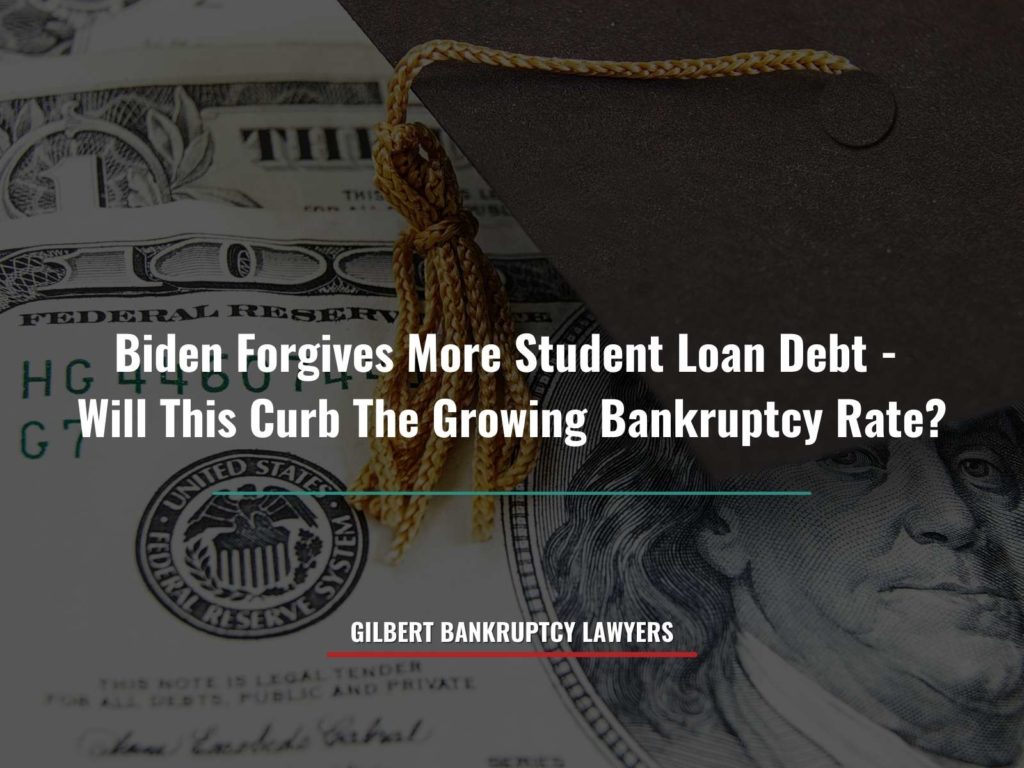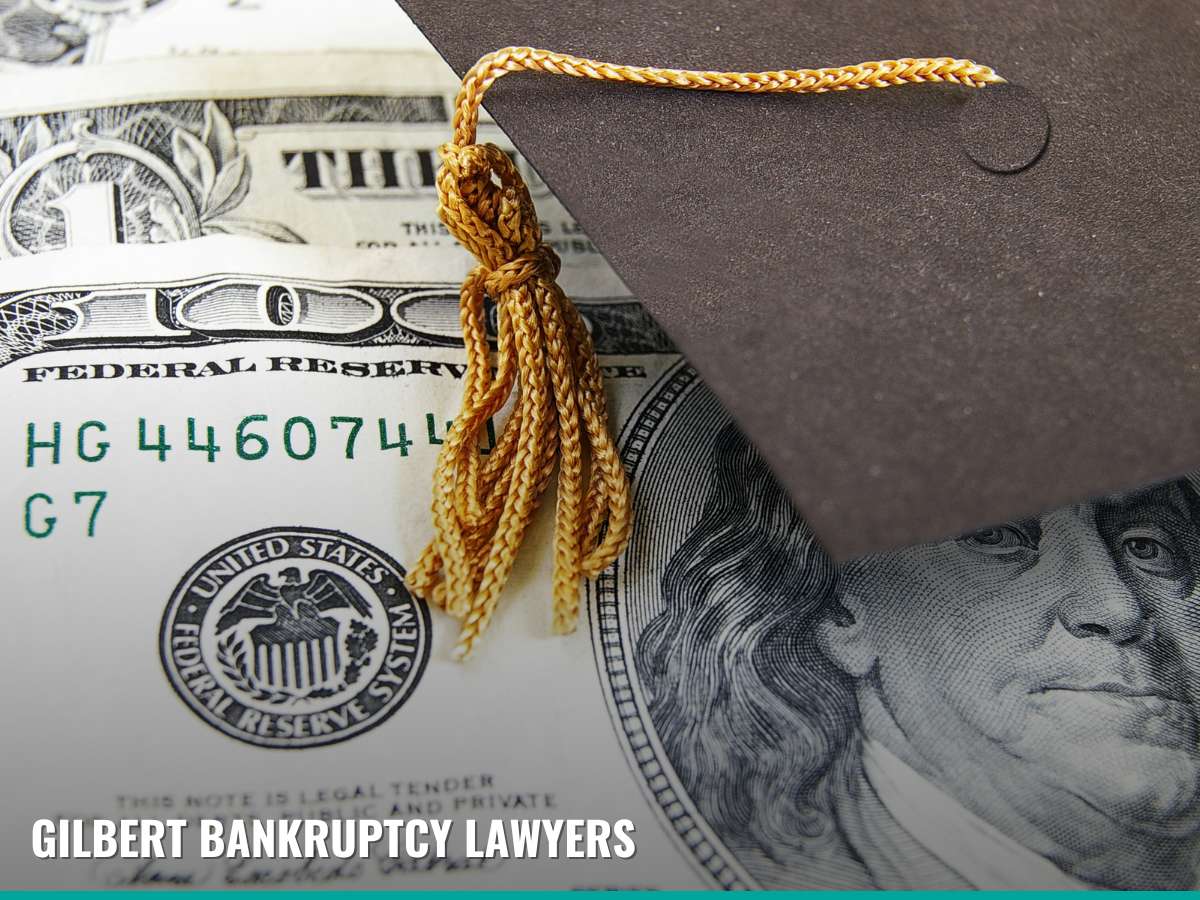On February 21, 2024, the White House issued an announcement that it would once again be forgiving student loans- this cancellation of $1.2 billion in debt will affect approximately 153,000 borrowers. This brings the total student debt forgiveness of the Biden-Harris administration to $138 billion for 3.9 million borrowers. This announcement comes in times when the cost of living is high and salaries have not been increasing at the same pace. This is demonstrated by the 18% increase in bankruptcy filings between 2022 and 2023. This latest round of student loan forgiveness will only impact borrowers who meet certain requirements. Will this latest round of loan forgiveness help slow down bankruptcy filings, which are expected to stay on the rise in 2024? How does bankruptcy affect someone who is struggling with student loan debt? Read on for the answers to these questions, and if you’re seeking a free consultation with an experienced Phoenix bankruptcy lawyer, call 480-448-9800.
Eligibility Criteria For Biden’s New Student Loan Forgiveness Initiative
Not every student loan borrower will have their loans forgiven through this latest announcement. It will apply to borrowers in a SAVE, or Saving on a Valuable Education, repayment plan. It is meant for borrowers with $12,000 in less in student loans that have been in repayment as little as 10 years. This provision was originally meant to go into effect in July 2024, but has been introduced 6 months early. Because this round of student forgiveness is aimed at lower-value loans, it is meant to assist those seeking an education as a “pathway to the middle class.” Previous student loan forgiveness efforts by the Biden-Harris administration have capped interest rates and reduced monthly payments for student loan borrowers. If you believe you will be included in this round, keep an eye on your email for the notification of your student loan forgiveness.
Understanding The Relationship Between Bankruptcy & Student Loan Debt
Student loans are difficult to discharge with bankruptcy- otherwise, the bankruptcy rate would probably be much higher. However, bankruptcy can help a borrower struggling with a student loan wage garnishment to get back on their feet and clear other debts to free up income to pay off student loans.
When a person falls too far behind on loan payments, their creditor may eventually pursue them for payment with more dramatic measures. A wage garnishment is an automatic deduction from the debtor’s paycheck that goes straight to their creditor. Only one creditor can have a wage garnishment in place on a debtor at a time. If another creditor wishes to garnish the wages of a debtor whose wages are already being garnished, they can “wait in line” and their garnishment will begin after the first one ends. A creditor can add extra charges to the balance of a wage garnishment debt like interest and legal fees. Wage garnishments can become a huge and never-ending drain on a debtor’s income that will make it harder for them to get out of debt and even afford normal daily expenses.
Student loan wage garnishments are capped at 15% of the debtor’s income. While this amount is high, it isn’t as high as the maximum wage garnishments for other types of debts. The standard wage garnishment in Arizona is 25% unless the debtor can show that the garnishment is causing severe financial hardship, at which point it can be reduced to 15%. There are unique rules that apply to wage garnishments that come from unpaid child support. The maximum child support wage garnishment is 50% if the debtor has other dependents. This increases to 60% if the debtor has no other dependents. Either of these can be increased by 5%- so 55% or 65%- if the debtor is behind on child support payments by 12 weeks or more.
There aren’t many ways to stop a wage garnishment once it is in effect. That is why many people turn to bankruptcy. Filing for bankruptcy activates the automatic stay, which stops wage garnishments among a variety of other creditor collection methods. While bankruptcy won’t wipe away student loan debt, it can put a pause on monthly payments and a student loan wage garnishment. This can last as long as the automatic stay does, which is usually until a bankruptcy case is discharged or dismissed. A chapter 7 bankruptcy usually lasts about 3-5 months from filing to discharge. A chapter 13 bankruptcy lasts either 3 or 5 years. For more questions about which chapter of bankruptcy to use and how long your automatic stay will last, contact our firm for your free consultation at 480-448-9800.
While it is highly unlikely that filing for bankruptcy will discharge a student loan borrower’s educational debt, it can be used to clear other types of debts so that the borrower can more easily afford to pay off their student loans. For example, a person may file for chapter 7 bankruptcy and clear thousands of dollars’ worth of credit card debt. Without extra expenses like late fees and interest, the debtor may have a more reasonable path to paying off their student debt.
How The Biden-Harris Policy Shift May Affect Student Loan Discharge In Bankruptcy
Filing for bankruptcy to clear student debt used to be a rare exception to the rule that student loans aren’t cleared by bankruptcy. Courts applied the Brunner Test to a debtor’s situation to determine whether or not their student loans were eligible for a bankruptcy discharge. This test had three factors to determine the eligibility of student loan discharge:
- Whether or not the debtor can maintain a minimal standard of living if required to repay the loan.
- Whether it is likely that the debtor’s income will remain the same.
- Whether the debtor made good faith efforts to repay the loan.
While these three factors may seem simple, in application it was rare that they could be used to clear educational debts in bankruptcy. However, one of the ways the Biden-Harris administration has fought our country’s student debt crisis is by making student loan debt easier to discharge in bankruptcy. With the Biden administration’s change in bankruptcy policy, a student loan borrower should now submit a financial attestation as part of their filing. This attestation will be reviewed to determine if the loan is causing undue hardship, rather than applying the Brunner Test. This change has been shown to be a relaxed standard, as 99% of applicants qualified for a full or partial discharge of their student debts with this new rule. If you have questions about whether or not your student loans are dischargeable in bankruptcy, call 480-448-9800 to schedule your free consultation with our firm.
How The Biden-Harris Policy Shift May Affect Student Loan Discharge In Bankruptcy
Our country’s bankruptcy rate has been increasing since pandemic measures were lifted, and student loans becoming easier to discharge may give you more incentive to file. On the other hand, Biden’s student loan forgiveness may eliminate the necessity of filing for bankruptcy to get a handle on student loan debt. To learn more about your options when it comes to filing for bankruptcy in Arizona, you can discuss your situation with an experienced professional with no risk or obligation. To schedule your free phone consultation call 480-448-9800 or contact us today at Gilbert Bankruptcy Lawyers.
Gilbert Bankruptcy Lawyers
Office: 480-448-9800
Email: info@myazlawyers.com
Website: https://gilbertbankruptcylawyers.com
Additional Information at:
Phoenix Bankruptcy Lawyer
Mesa Bankruptcy Lawyers
Phoenix DUI Lawyer
Chandler Bankruptcy Lawyer
Tempe Bankruptcy Lawyers
Vegas Zero Down Bankruptcy Attorney
Gilbert Bankruptcy Lawyers
Tucson Bankruptcy Lawyer
Arizona Zero Down DUI
Las Vegas Bankruptcy Lawyers
AZ Bankruptcy Lawyer

